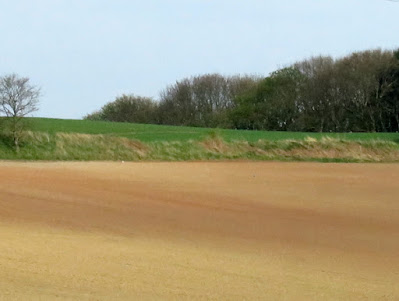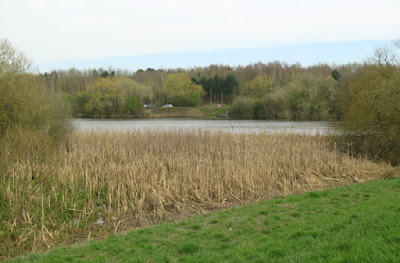 |
| Wild garlic in Treeton Wood |
Continuing with my exploration of Treeton Wood during the Covid-19 Lockdown, I followed the path along its eastern edge before taking a quick diversion along an unmarked path that passes over the adjacent ploughed field, to take a few photographs of the landscape from here.
 |
| A view towards Ulley |
Looking towards Ulley, the red fields on the Mexborough Rock in the distance contrast strongly with the soil on which I was standing, where innumerable small pieces of fine grained, light brown sandstone are found on the surface.
 |
| Rock fragments in the soil |
Making my way down the steep slope here, I came across a small stream, which springs just beyond Treeton Wood and marks the boundary between Treeton Wood and the agricultural land that runs up to the back of Falconer Wood and Hail Mary Hill Wood to the south.
 |
| Blocks of sandstone in the stream bed |
With steeply sloping ground above me to the right, I followed it downstream and, for part of its upper course, it cuts a steep v-shaped profile and its bed is occasionally littered with small pieces of laminated sandstone/siltstone; however, I didn’t see anything other than mudstone that had weathered to yellowish clay in its stream banks.
 |
| Weathered mudstone in the stream bank |
Further downstream, in places there is no well defined channel and areas of relatively flat, periodically flooded land are found, where wild garlic grows in abundance, and after gathering some of this to use for cooking later, I carried on down to the north-west corner of Treeton Wood.
 |
| Erosion by a temporary stream channel |
Leaving the wood, I then took a few photographs of the landscape around me before following the path to Hail Hill Mary Wood, which I am told often gets very muddy. The stream is culverted here but it soon reappears at the edge of this wood, before flowing down to Treeton Dyke.
 |
| The geology around treeton Wood |
Today, this stream forms a very minor watercourse but, looking at an Ordnance Survey map and a geological map, it occupies a distinct geographical feature that cuts through the escarpment of Treeton Rock and which is marked as being full of alluvium – evidence of the erosion and deposition that has taken place here for very many years.
 |
| A view of Treeton Wood and Hail Mary Hill Wood |
Stopping only to take note of the steeply rising ground that runs up to the summit of Hail Mary Hill, I followed the track that passes the new housing estate back to Treeton, where I looked back over some of the land that I had explored during my circular walk.
 |
| A walk around Treeton Wood |















































